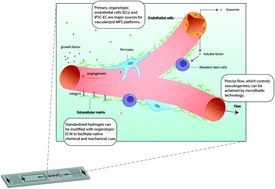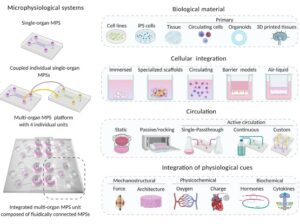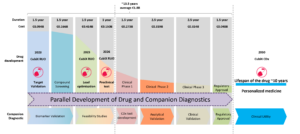Introduction
The phrase ‘vascular niche’ refers to a region rich in blood arteries where endothelial cells and mural cells, such as pericytes and smooth muscle cells, create a microenvironment that influences the activity of various stem and progenitor cells. Microphysiological system allow the recapitulation of the vascular niche in 3D cell culture.
As a novel technology for in vitro toxicity testing platforms in recent years, Microphysiological Systems (MPS) have been actively developed. MPS are cultural techniques for the rebuilding of human organs and tissue functions in a confined environment for the development of miniature human experimental systems. As methods for in vitro toxicity evaluation of next-generation, MPS offer considerable promise.

How to culture vascularized & immunocompetent 3D models in a standard Multiwell
Abstract of the vascular niche in next generation microphysiological systems
The authors state that “In recent years, microphysiological system (MPS, also known as, organ-on-a-chip or tissue chip) platforms have emerged with great promise to improve the predictive capacity of preclinical modeling thereby reducing the high attrition rates when drugs move into trials.
While their designs can vary quite significantly, in general MPS are bioengineered in vitro microenvironments that recapitulate key functional units of human organs, and that have broad applications in human physiology, pathophysiology, and clinical pharmacology. A critical next step in the evolution of MPS devices is the widespread incorporation of functional vasculature within tissues.
The vasculature itself is a major organ that carries nutrients, immune cells, signaling molecules and therapeutics to all other organs. It also plays critical roles in inducing and maintaining tissue identity through expression of angiocrine factors, and in providing tissue-specific milieus (i.e., the vascular niche) that can support the survival and function of stem cells. Thus, organs are patterned, maintained and supported by the vasculature, which in turn receives signals that drive tissue specific gene expression.
In this review, we will discuss published vascularized MPS platforms and present considerations for next-generation devices looking to incorporate this critical constituent. Finally, we will highlight the organ-patterning processes governed by the vasculature, and how the incorporation of a vascular niche within MPS platforms will establish a unique opportunity to study stem cell development.”
References
Ewald, M. L., Chen, Y. H., Lee, A. P., & Hughes, C. C. W. (2021). The vascular niche in next generation microphysiological systems. Lab on a Chip, 21(17), 3244–3262. https://doi.org/10.1039/d1lc00530h
FAQ
Microphysiological Systems, or MPS, are platforms that have been developed for in vitro toxicity evaluation. They are also known as organ-on-a-chip or tissue chips. These systems are cultural techniques. They are used to rebuild the functions of human organs and tissues within a confined setting, creating miniature human experimental systems. In general, MPS are bioengineered in vitro microenvironments. These environments are designed to copy the main functional units of human organs. The systems show good potential for improving the predictive capacity of preclinical modeling. This is important because the goal is to reduce the high failure rates that occur when new drugs move into clinical trials. These platforms have applications in studying human physiology and clinical pharmacology.
The term ‘vascular niche’ describes a specific region. This area is rich in blood arteries. A microenvironment is created here by endothelial cells and mural cells, such as pericytes. This local environment influences the activity of different stem and progenitor cells. The vasculature provides these tissue-specific milieus. These milieus are able to support the survival and function of stem cells. Microphysiological systems are related to this concept. MPS technology allows for the recreation of the vascular niche in a 3D cell culture. Including a vascular niche within MPS platforms is seen as an important next stage in their development. This addition is expected to create a distinct opportunity. It will allow for the study of stem cell development in a new way.
The widespread incorporation of functional vasculature is considered a necessary next step in the development of MPS devices. The vasculature itself is a major organ. It is responsible for carrying nutrients, immune cells, and signaling molecules to all other organs. Therapeutics are also transported by the vasculature. Beyond transport, it has other functions. It is involved in inducing and maintaining the identity of tissues. This is done through the expression of angiocrine factors. It also provides the specific environment of the vascular niche, which supports stem cells. Organs are patterned, maintained, and supported by their vasculature. In turn, the vasculature gets signals that lead to tissue-specific gene expression.
Microphysiological Systems are developed for use as in vitro toxicity testing platforms. They are seen as offering good potential as methods for in vitro toxicity evaluation. More broadly, MPS are bioengineered microenvironments. These are designed to copy the main functional units of human organs. As such, they have applications in the study of human physiology. They are also used in pathophysiology, which is the study of disease processes. Clinical pharmacology is another field where they are applied. A main goal is to use them in preclinical modeling. The systems have the potential to improve the predictive capacity of this modeling. This could help reduce the high attrition rates for drugs as they move into human trials.





